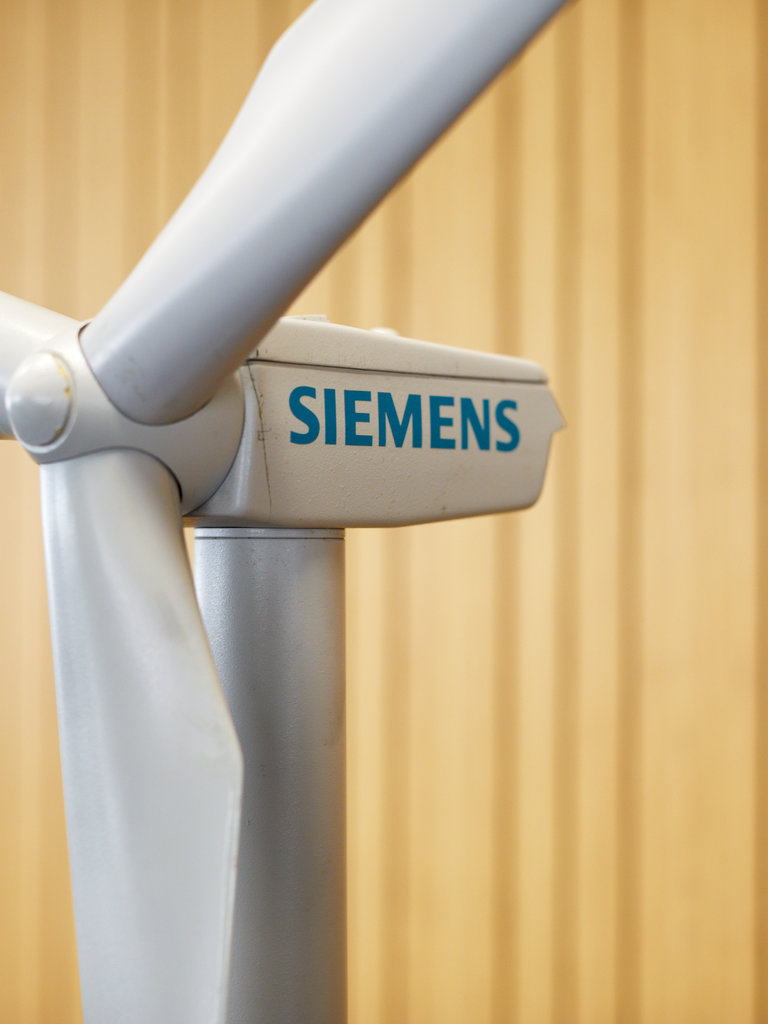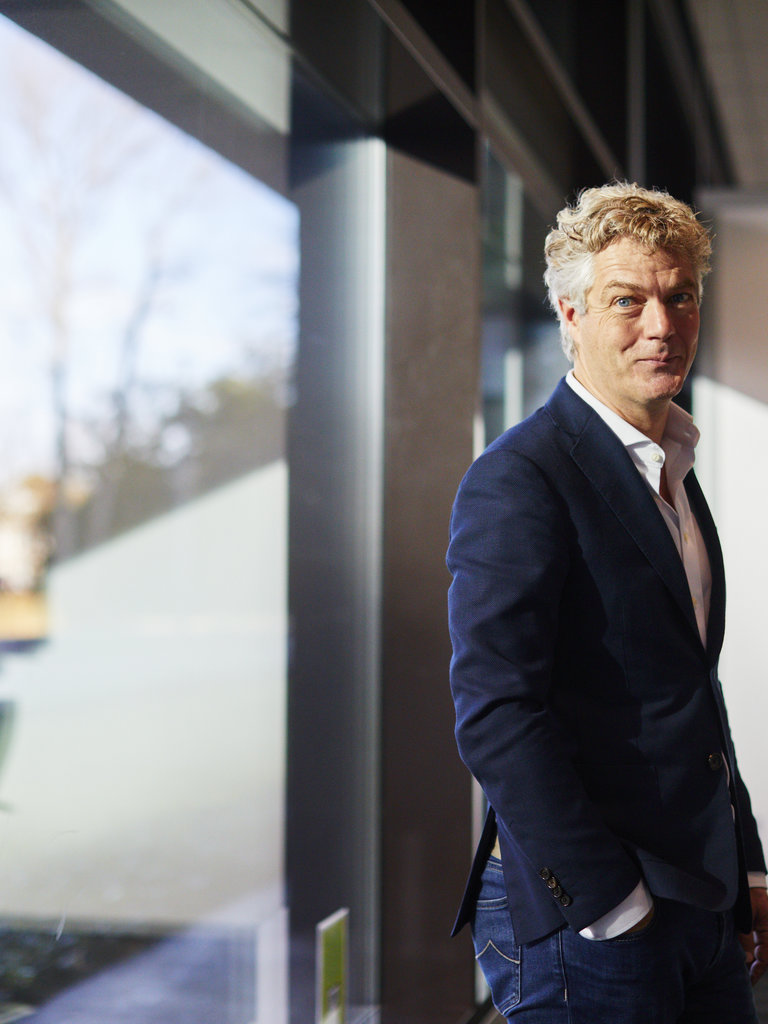
By: Karin Postelmans
Siemens Gamesa Renewable Energy and TU Delft are collaborating on the Dynamic Wind Farm Flow Control research project. The seeds of the alliance were first sown back in 2001. PhD candidate David Molenaar needed a test field for his research into the cost-effective design and control of wind turbines and established an alliance with the company (then still known as Siemens). Now managing director of SGRE Nederland, he explains why the wind industry and TU Delft need each other. And why that makes him happy.
Siemens Gamesa Renewable Energy (SGRE) is the world’s largest producer of offshore wind farms. The company can make a substantial contribution to resolving the climate issue while also accelerating the energy transition. The Dutch arm of the company is based in The Hague and is headed by David Molenaar. He did his degree and doctorate at TU Delft before joining Siemens as a sales engineer.
Pioneering
Molenaar: “What I missed while working on my PhD was proper collaboration with industry. That’s why I sought it out myself at the time. I even interrupted my PhD research to do it. It was real pioneering in those days. Fortunately, we’ve moved on a lot since then.”
TU Delft and SGRE are collaborating closely on the TU Delft project Dynamic Wind Farm Flow Control (DWFFC), that is part of Crosswind (an alliance between Shell and Eneco). The project’s aim is to reduce the ‘wake effect’. Molenaar: Within DWFFC, Delft scientists can test the models and algorithms they have developed in a real offshore wind farm. (See box).
Reduced wake: improved production, lower costs
A wind turbine alters the air dynamics, creating a kind of plume behind the rotor blades. This ‘wake effect’ means that wind turbines catch each other’s wind, reducing energy production. To combat this, TU Delft is testing two technologies as part of the DWFFC project. Closed active wake mixing shortens the wake and actively changes its direction, away from other turbines. HELIX active wake mixing is used to control the speed of individual turbines in a farm, ensuring that there is more wind left for the turbine behind. Both technologies improve energy production and continuity. If it ultimately becomes possible to build turbines closer together, costs could also be reduced. The project was launched in April 2021.

Using Delft algorithms to control wind farms
Controlling a wind turbine in a wind farm based on models is an advanced form of control technology largely developed in Delft. Molenaar: “An amazing amount of expertise is concentrated in Delft. Our wind farms also make it possible to test new technologies in practice. The researchers use the results to optimise their models. Ultimately, we then apply those improvements in practice. That symbiosis accelerates the development of the technology. It also offers opportunities for speeding up the energy transition.”
Molenaar has used the knowledge and insights that SGRE is acquiring from this alliance in his conversations with government when he encountered issues with regulation and long licensing processes. “They were designed with the right intention, but ultimately delivered the wrong result. For example, in the past wind turbines were often chosen based on types that delivered the most subsidy rather than those that generated the most power.” That has now changed. And licences primarily stipulate conditions concerning nuisance, environment and nature, rather than technical specifications and restrictions. “The alliance with TU Delft provided knowledge and insight that enabled me to make that clear. That makes it possible for politics to make adjustments.”
The energy transition is the most comprehensive action we can take to combat further climate change

Six-fold increase in speed
Adjustments are definitely needed, in view of the Dutch government’s climate goals. As of the end of 2021 there are offshore wind farms with a total capacity of 2.5 gigawatt (GW). According to the Energy Agreement (2013), offshore wind energy must be able to supply at least 4.5 GW by 2023. It was agreed in the Climate Agreement (2019) that there will be 11.5 GW of wind farms offshore by 2030. That was recently increased to 22.2 GW, or more than 16% of all of the energy in the Netherlands.
“It took thirty years to reduce national CO2 emissions by 40 Mt. We now need an 80 Mt reduction in the space of a decade. To achieve that, you need a six-fold increase in speed," calculates Molenaar. “That’s the equivalent of an additional wind turbine every other day."
Optimising together
Between 2010 and 2018, the focus was on reducing the costs of wind energy. The turbines became increasingly taller as a result. The whole supply chain had to make changes. Every turbine that is larger in size features new specifications for the foundations, tower, rotor blades and installation vessels, among other things. The Hollandse Kust Zuid offshore wind farm (Vattenfall, 2018) was the world’s first financially viable, subsidy-free wind project.
Now that wind farms are financially viable without subsidy, and there is a social need for faster CO2 reduction, you have to set different goals, according to Molenaar. “Not the lowest costs, but lifespan and reuse." Molenaar is calling for European agreements that would fix the maximum tip height for a decade, for example. “That kind of condition is needed to speed things up and set the bar higher every year for CO2 reduction, lifespan and zero waste." Some progress was made recently: the licence period for new projects has been extended from 25 to 40 years. “That makes a real difference," emphasises Molenaar. “It provides long-term security for the capital-intensive wind industry, in which funding and licence duration are linked."
Interesting, both commercially and for the climate
Securing the future is also a key result of the collaboration with TU Delft. “Our shared objective is to make progress on climate change. In that respect, research opens up prospects for the future. What possibilities are there and what is worthwhile investing in?” Molenaar gives an example. In the case of onshore wind turbines, the tower and the foundations were designed separately. That was possible on land, but not offshore, where the situation is much more dynamic. SGRE joined forces with a TU Delft student to find out how much steel we could save if we designed a single unit. Molenaar: “The graduation project revealed that we could use up to 25% less steel. That’s of benefit both commercially and in terms of the climate: steel accounts for 40% of the CO2 emissions of wind turbines.” It resulted in an engineering department that is responsible worldwide for the integrated design of offshore towers and foundations. “Incidentally, it’s led by Dr Sven Voomeeren, who completed his doctorate at TU Delft with SGRE’s support."
More than a hundred graduation internships
In Molenaar's view, the secret behind a collaboration's success is openness. “Be upfront about what you expect from the other party. What you want to achieve yourself and what challenges you see. And make agreements about that. And if something goes wrong, let each other know." He acknowledges that this requires trust. “When I was studying and doing my doctorate at TU Delft, I saw for myself how far you can come if you are given the space and confidence you need. If you’re allowed to try things out and learn from mistakes. That’s something I took with me to SGRE. And I also try to give some of it back." More than a hundred students have now completed graduation internships at SGRE. The company has already enabled four PhD research projects and a fifth recently started.
An awful lot of fun
Ultimately, Molenaar's message is that you make more progress and do so faster by working together. So, what is his personal motivation for collaboration? “Above all, it’s an awful lot of fun! The great atmosphere, the vibe with the scientists, the fresh perspective they bring to challenges. And, of course, the latest developments that it enables you to put into practice. It’s something that makes me really happy.”